Good morning world. Moon setting next to Table Mountain from Somerset West: image via Alfred Thorpe @vuurtoring. 6 November 2014
There is a grapefruit moon out there and tart cherry juice
Was the arthritis remedy suggested to me by the woman who had just emerged from her vehicle after
Demolishing it in a four-car pileup out front on the freeway feeder, and as
The crowd gathered, I looked up, saw spots
Created by the sunlight filtering through the polluted walnut trees
The phenomenon which causes the continuous house rocking heart stopping chain collisions here on the freeway feeder
As the uphill speeders come round the S curve, floor it to make it through the light, are blinded
The social order that was is no more there is only the race to make it through
The light, and there, the ragged OG, I took thought, nobody cared or noticed
As always happens since that Jetta jolted my membership in the social
Order and the chaos to be controlled, to be controlled, that
Would be the aim as indeed it must be to survive
Within the murmuration, the mutually protective gathering of souls in migration,
There's just no way to say it that applies
To this doomed isolato species, whereas the starlings are numerous and sociable, they gather together, they will survive
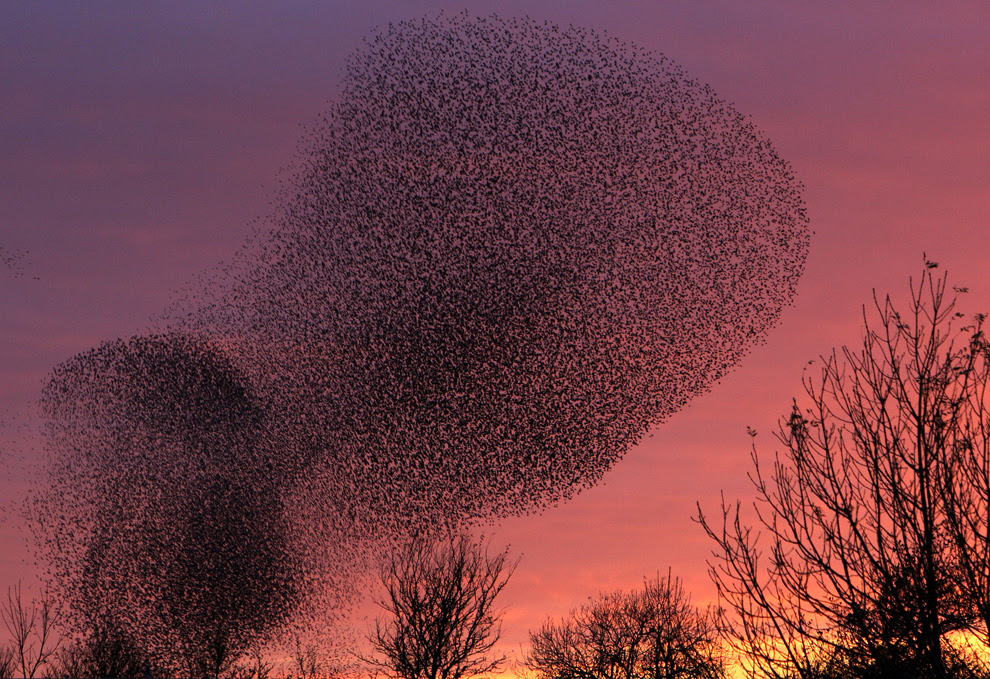
A murmuration of starlings fills the evening sky above Gretna, Scotland: photo by Scott Heppell / Associated Press, 2011
Amazing shot from Copter4 of tonight's #fullmoon as an airplane from @DENAirport flies through the frame: image via Mark Neitro @CBS4Mark, 6 November 2014
For its beauty the #Starling i think is a very underestimated bird, the glint in its eye is actually my conservatory: image by Martin.M. @som_nature_spy, 27 October 2014
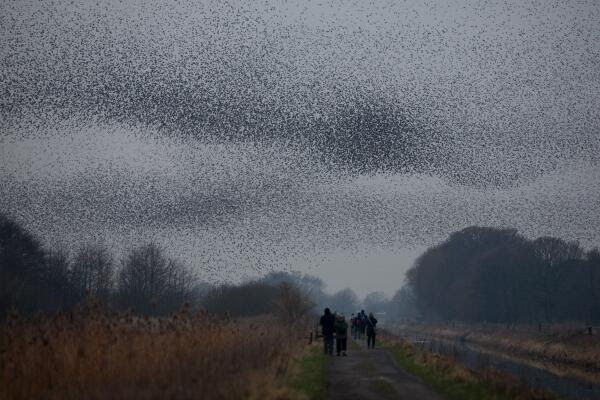
Would love to see a murmuration! MT @naturebygreen: One of my best #starling #murmurations from last year in Somerset: image by Carol Probets @carolprobets, 21 January 2014
When #starling #murmurations suddenly descend into reedbeds, the sound is like the whoosh of an aircraft engine: image via iain green @naturebygreen, 23 January 2014
Thousands of Starlings coming in to roost on Shapwick Heath this evening: image via Mark Pollock @PollockMark, 29 January 2014
RT @The Atlantic The #murmurations of starlings: image via Andrew Russell @amruss1, 1 March 2014
This is a flock of starlings. Amazing!: image via Odhrán Allen @odhranallen, 1 March 2014

Starlings at Westwood Marshes, Suffolk: photo by Neil MP / Green Shoots via The Guardian, 17 October 2014
Tomorrow night I will follow them to their roost and become more intimate. #Murmurations: image via Mick Ryan @vertical_brain, 5 March 2014
One more #Murmurations from tonight in the Peak: image via Mick Ryan @vertical_brain, 5 March 2014
BBC News - Starlings: Mapping and modelling the ballet of the skies: image via Carol @RickysFlower, 27 October 2014
See stunning images of #starlings putting on incredible displays in #Scotland: image via ScotsUSA@scotsusa, 6 November 2014
It's that time of year again! Seen any good #starling #murmurations yet?: image via BTO @_BTO, 7 September 2014
Breathtaking > MT @BTO: #starling murmurations are like liquid helium apparently - who knew?: image via Dominic Mitchell @birdingetc, 29 October 2014
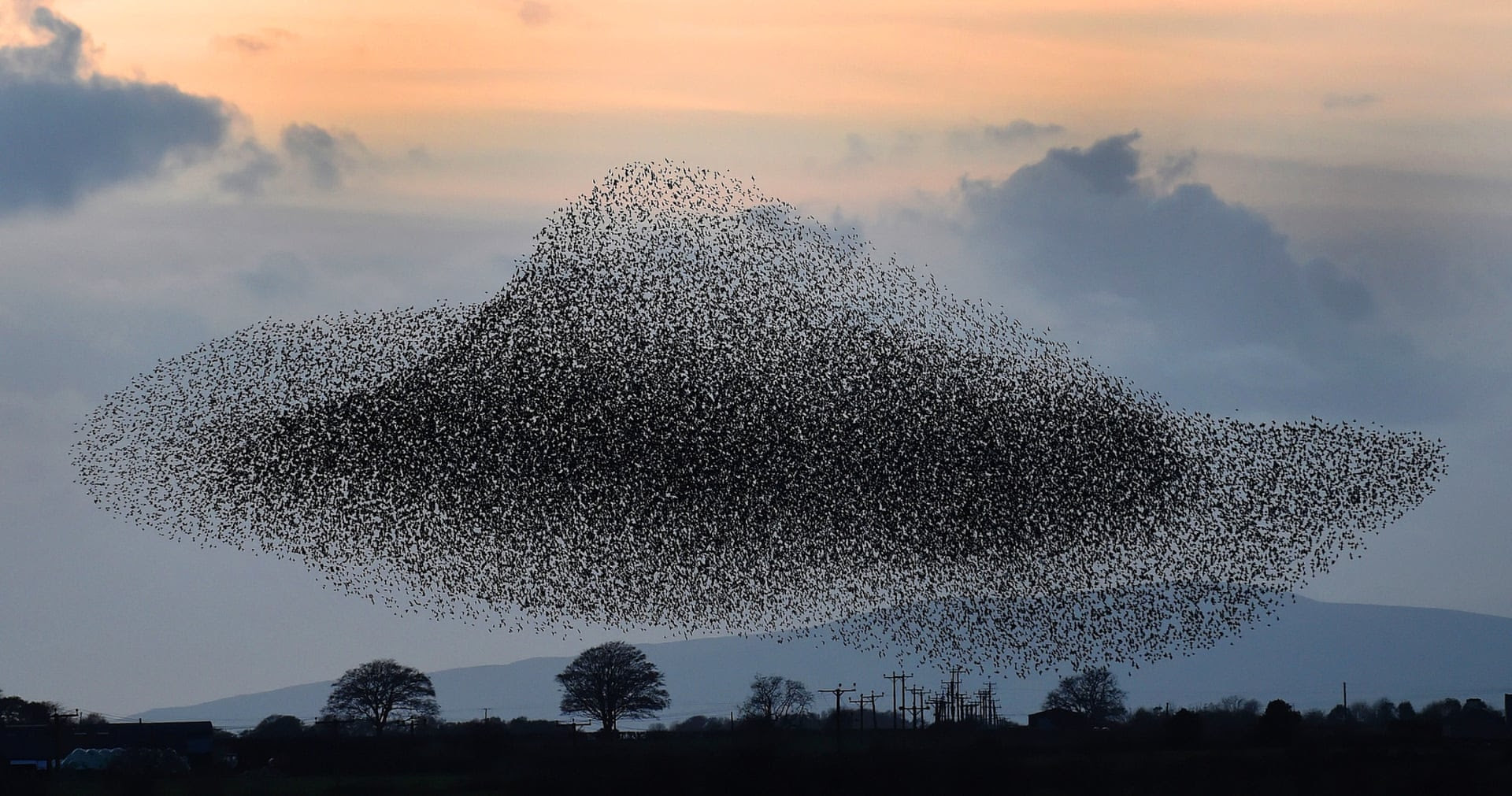
Autumn, near Gretna Green. Dark clouds begin to form in the sky above fields, woodlands and reed beds. But these are no ordinary clouds. They are one of the UK’s most incredible wildlife spectacles: starlings starting their autumnal murmuration: photo by Owen Humphrey / Press association via The Guardian, 6 November 2014

Throughout the autumn and winter months, hundreds of thousands of starlings turn the sky black around the UK. The birds come together in huge clouds, wheeling, turning and swooping in unison in formations known as murmurations: photo by Owen Humphrey / Press association via The Guardian, 6 November 2014

Starlings join forces for many reasons. Grouping together offers safety in numbers – predators such as peregrine falcons find it hard to target one bird amid a hypnotising flock of thousands: photo by Owen Humphrey / Press association via The Guardian, 6 November 2014

Starlings also gather to keep warm at night and to exchange information, such as good feeding areas. They often feed miles away from where they roost – sometimes up to 20 miles away. They return to their roosting site at around the same time each evening: photo by Owen Humphrey / Press association via The Guardian, 6 November 2014
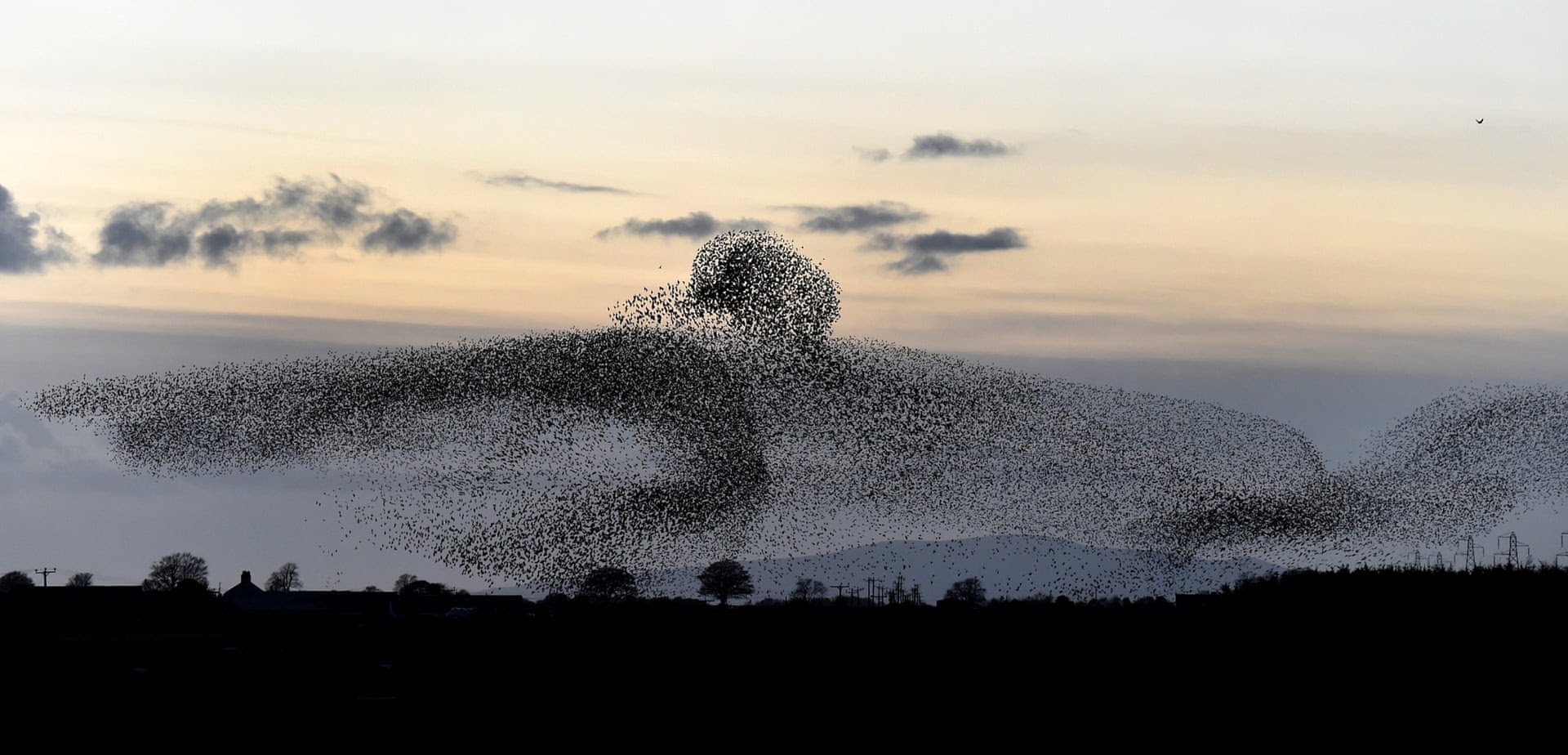
Early evening, just before dusk, is the best time to see them across the UK as they perform their aerial dance and choose their communal night-time shelter. They roost in places that are sheltered from harsh weather and predators: photo by Owen Humphrey / Press association via The Guardian, 6 November 2014

They tend to roost in woodlands, but reedbeds, cliffs, buildings and industrial structures are also used. During the day, however, they form daytime roosts at exposed places such as treetops, where the birds have good all-round visibility: photo by Owen Humphrey / Press association via The Guardian, 6 November 2014

Autumn roosts usually begin to form in November, though this varies from site to site and some can begin as early as September. More and more birds will flock together as the weeks go on, and the number of starlings in a roost can swell to around 100,000 in some places: photo by Owen Humphrey / Press association via The Guardian, 6 November 2014

The huge gatherings
are at their largest in winter, as they are boosted by thousands of
migrant birds visiting from Europe for Britain’s milder Atlantic
climate: photo by Owen Humphrey / Press association via The Guardian, 6 November 2014
just part of 40K #murmurations of starlings @RSPBMinsmere on Sat evening -- magical!: image via Simon Waters @SuffolkSi, 26 October 2014

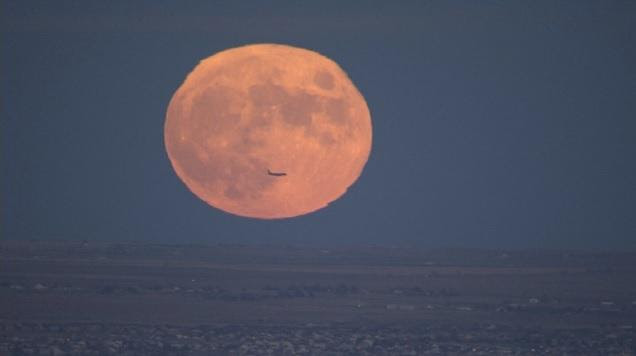
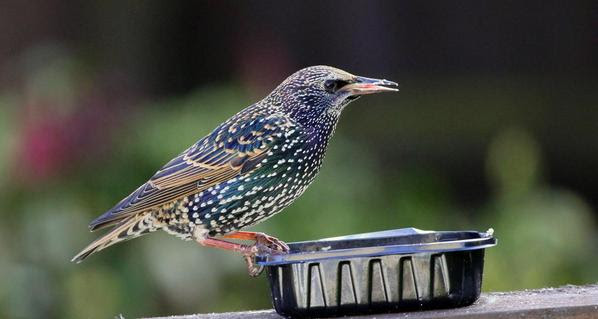

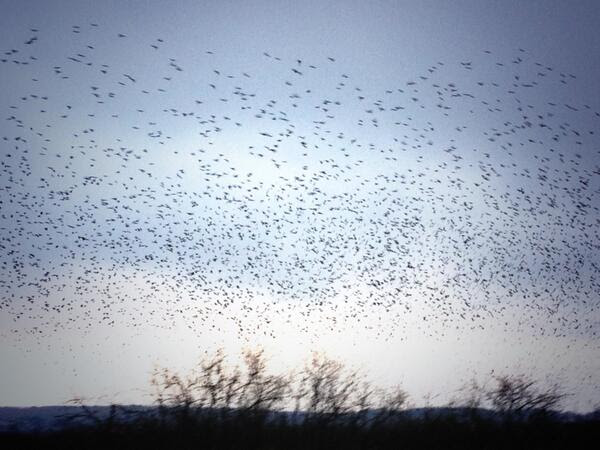
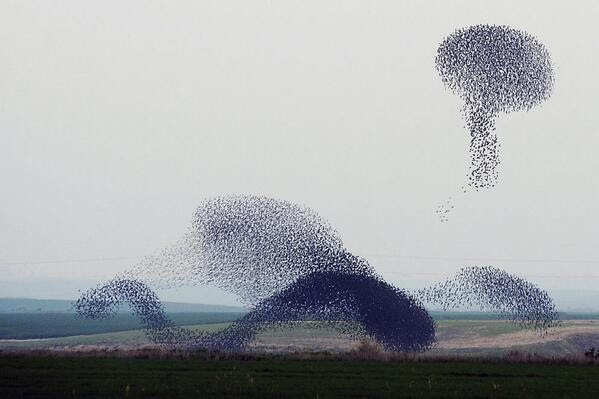
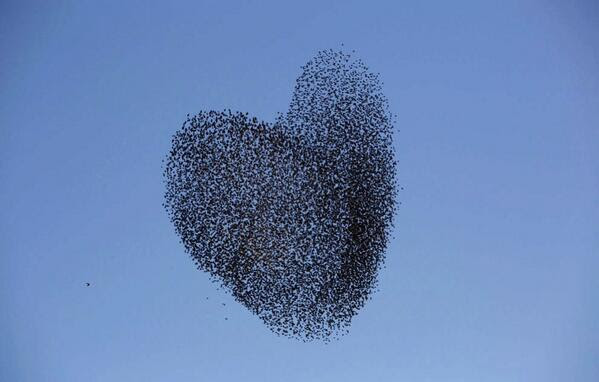

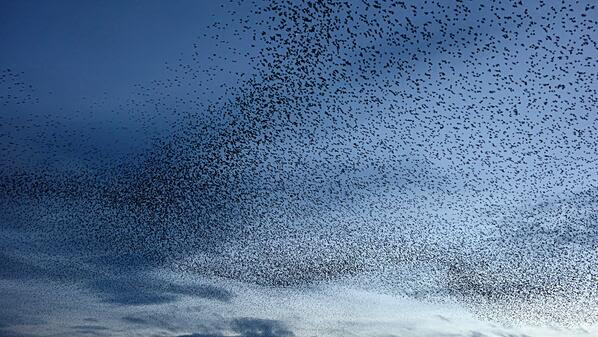



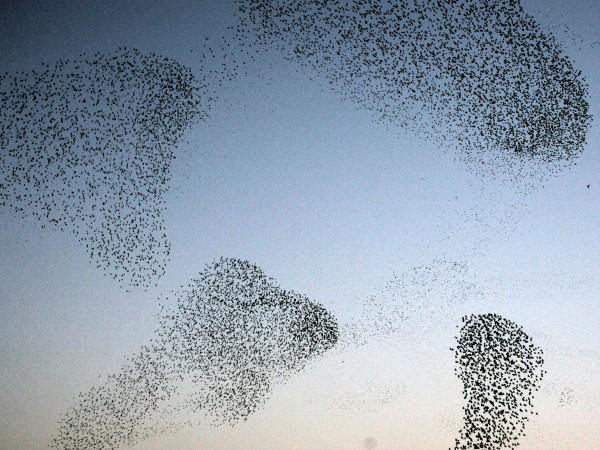
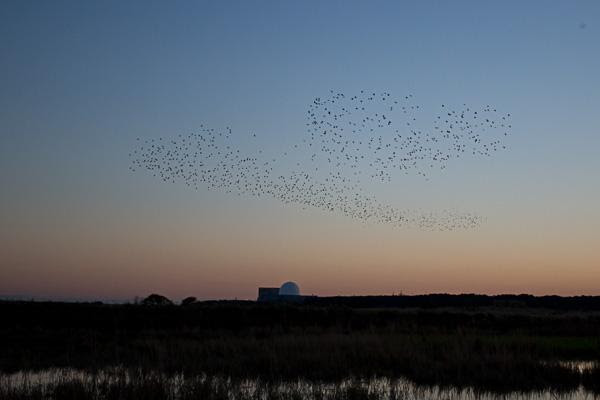
The starlings everywhere... have you noticed?
ReplyDeleteNovember gets more and more Nick Drake every year...
Pink Moon
Oh, Tom, this is beautiful.
ReplyDeleteOf course, they won't survive - nothing and no-one will; we're much too selfish and greedy to destroy only ourselves - we have to take down the rest, slowly and sordidly, with us.
beautiful your thoughts and pictures this morning
ReplyDeleteSuch astonishing images. Thank you.
ReplyDeleteI once wrote a poem I rather liked with the line "essaying the contrasts." I felt it a true line in the context of what I was imagining. It feels truer still this combination of your haunted poem & [placeholder for the right word] pictures.
ReplyDeleteThank you people, good to feel we're still here with the starlings.
ReplyDeleteBut... Well, so much for poetic licence. Fey is all too right. The starling may be numerous, but it is less numerous than it was yesterday. Urbanisation and agricultural intensification, which now threaten many of the most common European bird species, have done the starling little good. Its numbers have fallen by 53% in the past thirty years. In the same period there is a comparable decline in numbers of, to take two common examples, the house sparrow (62%) and the skylark (46%). European bird populations have decreased by some 420 million in the same period.
Someday school kids will be shown bird skeletons in airproof cases.
"Once upon a time, children, there were these small animals with feathers, which had wings and flew through the air -- they were the evolutionary predecessors of drones, but with the annoying feature of having their own control systems, some so odd that we had not yet sorted them out at the time the animal became extinct."
I think this is copyright, so perhaps you'll need to edit it for me:
ReplyDelete'To See the Rabbit’ by Alan Brownjohn
We are going to see the rabbit.
We are going to see the rabbit.
Which rabbit, people say?
Which rabbit , ask the children?
Which rabbit?
The only rabbit,
The only rabbit in England,
Sitting behind a barbed-wire fence
Under the floodlights, neon lights,
Sodium lights,
Nibbling grass
On the only patch of grass
In England, in England
(except the grass by the hoardings
Which doesn’t count.)
We are going to see the rabbit
And we must be there on time.
First we shall go by escalator,
Then we shall go by underground,
And then we shall go by motorway,
And then by helicopterway,
And the last 10 yards we shall have to go
On foot.
And now we are going
All the way to see the rabbit,
We are nearly there,
We are longing to see it,
And so is the crowd
Which is here in thousands
With mounted policemen
And big loudspeakers
And bands and banners,
And everyone has come a long way.
But soon we shall see it
Sitting and nibbling
The blades of grass
In – but something has gone wrong!
Why is everyone so angry,
Why is everyone jostling
And slanging and complaining?
The rabbit has gone,
Yes, the rabbit has gone.
He has actually burrowed down into the earth
And made himself a warren, under the earth,
Despite all these people,
And what shall we do?
What can we do?
It is all a pity, you must be disappointed,
Go home and do something for today,
Go home again, go home for today.
For you cannot hear the rabbit, under the earth,
Remarking rather sadly to himself, by himself,
As he rests in his warren, under the earth:
‘It won’t be long, they are bound to come,
They are bound to come and find me, even here.’
http://mrschircop.com/archives/sec-2014/were-going-to-see-the-rabbit-alan-brownjohn/
Fey, the poem is germane, and -- I recognized as I fiddled ineffectually with tentative edits that would wring things down to a bare gist -- the whole thing is to the point.
ReplyDeleteIn any case, who knows, perhaps Mr Brownjohn will take note that you have respectfully and expecting no benefit for yourself (only the good of all) deployed his poem to the end for which it was ostensibly intended, and be glad.